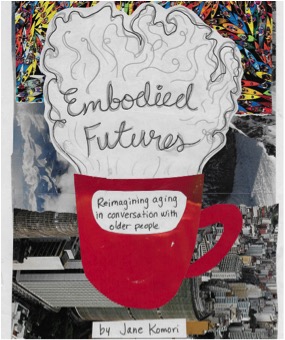Reading through Jane Komori’s comic, “Embodied Futures: Reimagining Aging in Conversation with Older People,” was a nostalgic experience: comics (specifically Japanese manga) were an important aspect of my upbringing. Just like the prevailing themes of chasing one’s aspirations of the future or being open minded to possibilities was instilled in the comics I’ve read, so did Komori’s work offer a similar message. In fact, Komori’s work encourages the viewer to reimagine conversations with the elderly that have a positive outlook on the present and towards the future.
In this reflection, I offer some remarks on “A Comic About Aging Together: Embodied Futures” by Jane Komori, and explore how this piece of graphic artwork can be understood as an example of what Kathleen Woodwarddescribes as an evocative object, specifically one that challenges ideas of intergenerational divide. In Woodward’s essay, “Inventing Generational Models: Psychoanalysis, Feminism and Literature” she defines an evocative object as a “cultural text” that helps older individuals imagine possible futures. The title of Komori’s comic alone highlights how these ideas or inspirations for the future are embodied through the discussions had with the narrator and her grandmother. They are made tangible through dialogue, and further made permanent through the drawing on and putting together of different pieces of paper, to inevitable create the final production of this comic.
When reflecting on the medium in which Komori’s work is made from, I immediately remembered a discussion in our HLTD51 seminar in which Dr. Charise mentioned John Locke‘s conceptualization of the mind being a blank slate or a tabula rasa. Locke observed that the mind is like a blank slate where, from birth onward, aspects of one’s personality, knowledge, and worldviews are constantly being inscribed into one’s identity as they age.
In some ways, Komori’s work can be said to literalize some of Locke’s principles of experience: Paper in this case acts as a medium in which “Embodied Futures” creates pre-constructed environments and backdrops through magazine cut outs, which I argue act as a metaphor for the pre-existing structures in our daily lives (i.e. conceptualizations of aging, government allocation of funding on different types of care etc.). In addition, blank paper acts as a tabula rasa where the artist inscribed her own knowledge, personality and values into the narrative of the comic. Lastly, by using multiple layers of paper to create this comic, Komori’s aspirations for creating an arena of visibility for older people is solidified and made to be a permanent evocative object. The artist’s desire to challenge ageist rhetoric that imagines a more positive future can be seen on the last page of the comic that reads:
“Imaging the future means acknowledging a whole generation of voices that are rendered invisible by our ideas of valuable bodies, minds, abilities and temporalities”.
In addition, Komori’s work asks its audience to imagine themselves engaging in intergenerational dialogue that imagines a possible future for both the protagonist and her grandmother. In the comic, communication is highlighted as a tool that enables intergenerational understanding. Throughout the comic, communication technology is emphasized through the use of cellphones, telephones and even with the highlighting of the laptop during the “Quirk-E Queers Elder Group”. Moreover, the mouth and the body as being tools of social interaction that exude excitement for the future is important to note. An example is on page three where an older lady and a young boy are speaking as she lifts her hands in the air and says, “Lets form a dance group!” Not only is she enthusiastic about a possible future, it is one that focuses on the present or the now that Woodward mentions as a historical model essential to reimagining aging outside of what Margaret Gullette would call an “ideology of decline.” Through the dialogues that are being reported in this comic, the older protagonists invent and shape their futures by engaging with possibilities of what is to come next, no matter how near or far into the future is being imagined.
Evocative objects are not just wonderful artistic tools that illicit positive hopes towards the future for the elderly, but also become a tangible work of resistance against negative understandings of aging. These aesthetic works, especially art like Komori’s, are important in encouraging all of us to see an alternative future for ourselves. They also provide a nuanced perspective of aging that aid in combating normative generational binaries of ‘old’ and ‘young’ that remind us that we are all in the process of aging. We are in this together.
Key References
Komori, J. (2016). A Comic About Aging Together – Embodied Futures. Retrieved from: http://gutsmagazine.ca/a-comic-about-aging/
Woodward, K. (1999). “Inventing Generational Models: Psychoanalysis, Feminism andLiterature” in Woodward. Figuring Age: Women, Bodies, Generations (Indiana: IndianaUniversity Press. pp. 149-168.
